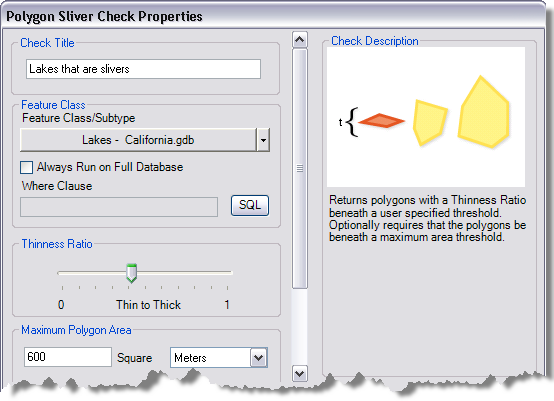Data Reviewer のライセンスで利用可能。
Polygon slivers can occur during extraction when small, thin polygons are accidentally created through an overlap with existing features. The factors that define a sliver polygon are the thinness ratio and the polygon's area. If the polygon is below a specified thinness ratio and value, it is considered a sliver.
The Polygon Sliver check finds sliver polygon geometries for features in a feature class, then returns them as results. The check can be run on an entire feature class, a subtype, or a set of features selected using a SQL query.
Once you have defined the criteria for the check, you can configure the notes and a severity rating. The notes allow you to provide a more specific description for the feature that has been written to the Reviewer table and are copied to the Notes field in the Reviewer table. The severity rating allows you to indicate how important the results from a check are in terms of your quality assurance/quality-control processes. The lower the number, the greater the priority the check's results have.
- Start ArcMap.
- On the main menu, click Customize > Toolbars > Data Reviewer.
- Click the Select Data Check drop-down arrow on the Data Reviewer toolbar, click the plus sign (+) next to Polygon Checks, then click Polygon Sliver Check.
The Polygon Sliver Check Properties dialog box appears.

- If necessary, type a unique name for the check in the Check Title text box.
- Click the Feature Class/Subtype drop-down arrow to choose the feature class and subtype on which to run the check.
- To run the check on the entire feature class and save this setting, check the Always Run on Full Database check box.
- To run the check on specific features in a feature class, click SQL to construct an SQL query.
- Move the Thinness Ratio slider to the position that best describes the thinness of a sliver polygon.
The farther right the slider is moved, the thicker the polygon must be to be recognized as a sliver.
- Type a value in the Maximum Polygon Area text box.
If the polygon's area falls below this value, it is considered a sliver.
- Click the Square drop-down arrow and choose the unit of measurement to use for the polygon area.
The units you can choose include both page and map units. Page units include inches, points, millimeters, and centimeters. Map units include feet, yards, miles, nautical miles, kilometers, decimal degrees, decimeters, and unknown units.
- If necessary, type descriptive text for the check results in the Notes text box in the Reviewer Remarks area.
- If necessary, click the Severity drop-down arrow and choose a value that indicates the priority of the check's results in the Reviewer Remarks area.
The severity indicates the importance of the check result. The values range from 1 to 5, with 1 being the highest priority and 5 being the lowest.
- [OK] をクリックします。
- Click the Run Data Check button
 on the Data Reviewer toolbar.
on the Data Reviewer toolbar.
The Features to Validate dialog box appears.

- Choose an option in the Features to Validate area.
- Selection Set—The check is run on the features that are currently selected in the map.
- Current Extent—The check is run on the current map extent, which is controlled by the map scale.
- Definition Query—The check is run on the features that are displayed based on definition queries that have been created for the feature class.
- Full Database—The check is run on all the features in the feature class.
- To run the check only on features that have been edited in a versioned workspace, check the Changed Features Only check box.
- Click OK.
The check is run on the extent specified on the Features to Validate dialog box.
When the check finishes, a check results dialog box appears.
- Do one of the following:
- If you want to browse the results in the Browse Features window, choose the Browse Results option.
- If you have started a Reviewer session and want to record the results in the Reviewer table, choose the Write to Reviewer Table option.
- [OK] をクリックします。